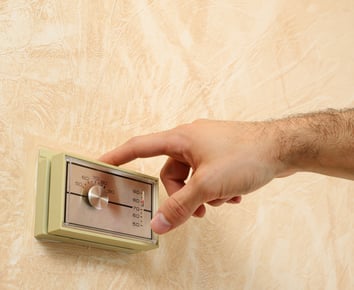
The problem of damp and mould in the social rented sector can only be solved when landlords have good data on the problem. Sensor networks can provide data that will not...
In recent years, there has been a growing focus on the impact of air and housing quality on the health of children. In 2022, the tragic death of a child was attributed to damp and mould, leading to the landlord being held accountable. As a result, there are plans to strengthen social housing regulations in the near future.
This article is the second in our series on damp and mould in the home. The others are:
Mouldy homes 1: how damp causes mould
Mouldy homes 3: knowledge gaps
Mouldy homes 4: how to dry out damp Britain
Mouldy homes 5: is infrared a solution?
In November 2022, Joanne Kearsley dropped a metaphorical hand grenade into the world of the landlord. It’s a hand grenade that many thought was long overdue.
Kearsley was the coroner responsible for the inquest into the death of Awaab Ishak, a two-year-old boy who had died two years earlier. The hand grenade was her verdict naming environmental mould exposure as a cause of his death and, in a report that accompanied the verdict, Kearsley went further: ‘action to treat and prevent the mould, was not taken’.
It placed the blame for Awaab’s death squarely on the Rochdale Boroughwide Housing Association (RBH), from whom Awaab’s family rented their home. Kearsley’s report went further, listing a series of warnings by local children’s services and RBH’s repair manager, none of which had been acted on. Instead, RBH attributed the mould inside Awaab’s home to what they called ‘ritual bathing’, although they never explained what that was supposed to mean or how it differed from simply using the shower.
Kearsley’s verdict was the first to name mould exposure as a cause of death in Britain and it caused shockwaves that reverberated from Rochdale to Westminster. Within hours of the verdict being returned, the Secretary of State for Levelling Up, Housing & Communities, Michael Gove, was airing his opinion on Sky News.
“It seems to me inconceivable that the chief executive of a housing association, earning north of £150,000, who is responsible for decent homes in Rochdale,” he said. “I mean honestly, it beggars belief that this guy is still in office.”
He added that the chief executive in question would be coming to Gove’s department “to explain himself”.
Two days later, the chief executive in question released a statement saying he would not be resigning and added that the RBH board ‘have given me their full backing and trust to continue to oversee the improvements and changes needed within RBH’.
Three days after that, the board fired him from his ‘north of £150,000’ job.
The repercussions of the inquiry are likely to reach far beyond RBH because mould is such a common problem in British homes, particularly in the rented sector for the reasons discussed in the preceding article. In a 2021 report [PDF], the Housing Ombudsman identified mould as an ‘all too familiar’ complaint and stated that more than half of those complaints led to a finding of maladministration by the landlord.
The report was scathing about landlords blaming their tenants for causing the mould, stating that ‘occupancy factors do not mean that the landlord has no responsibility, and landlords should recognise that some homes were not designed with modern living in mind’. For example, a landlord cannot write off a mould problem to a tenant drying clothes on a radiator if the tenant has nowhere else to dry their clothes. The argument was similar to that followed by Kearsley when she dismissed ritual bathing as an excuse for the Ishak family’s mould problem.
The Ombudsman went on to recommend that ‘landlords should adopt a zero-tolerance approach to damp and mould’ which, it explained, did not mean that there should be ‘zero cases’ – a probably unattainable goal – but that the onus was on landlords to address cases when tenants report them.
The Ombudsman’s findings were echoed by the National Housing Federation which, in the Better Social Housing review published in 2022, identified damp and mould as the most prevalent concerns among social housing tenants.
It’s hardly news that damp and mould are prevalent problems in the rented sector in general and the social rented sector in particular but the reports by the Housing Ombudsman and the National Housing Federation gave an unprecedented emphasis to the role of landlords. They prepared the ground for Kearsley to hold RBH responsible for Awaab Ishak’s death and pre-emptively dismissed many of the arguments that RBH deployed in their defence.
The Awaab Ishak verdict reflects a growing recognition that the air that children breathe is important for their health and conversely, that a child’s poor health may be caused by what is in that air. Recognition first arrived in the courtroom in 2020, when a London coroner named air pollution as a cause of the death of nine-year-old Ella Kissi-Debrah. Ella’s and Awaab’s were the first two deaths in Britain to be legally attributed to the air they breathed but they are unlikely to be the last.
Kearsley followed up her verdict with a report addressed to Gove, as the minister responsible for housing, and also to Health Minister Steve Barclay, both of whom can be obliged to respond by a coroner. Gove and Barclay [PDF] acknowledged the issue and pointed out that that damp and mould were covered by the Housing Health and Safety Rating System (HHSRS) which provides a framework for landlords to assess rented properties.
Their response made no specific commitments but it was not the end of the matter. The Manchester Evening News started a two-pronged campaign for legislative reform. One prong was for amendments to the Social Housing Regulations Bill that is currently under Parliamentary review, which would introduce short-notice inspections of rental properties and ‘increased professionalisation of housing management’. The second prong was a call for a new ‘Awaab’s Law’ that would introduce the following requirements for the landlords of social housing:
In February 2023, Gove tabled amendments to the Social Housing Bill [PDF] which was then passing through the House of Commons. Once it comes into force, the Ombudsman will have new powers to instruct landlords to either resolve problems like damp and mould or rehouse tenants affected by them. New powers have also been conferred on the Regulator of Social Housing, who will be able to issue unlimited fines.
The amendments fall short of what the Manchester Evening News is calling for and they only affect the social housing sector. However, Gove has also announced that a consultation on some version of ‘Awaab’s Law’ will be launched by the end of the year. It remains to be seen what the new law will contain, when it will come into force and how far-reaching it will be, although Citizen’s Advice has already called for it to be extended beyond the social rented to the private rented sector.
The new Awaab’s law, whatever it ends up being, is not the only reason to expect imminent change. A Decent Homes Standard specifically for the private rented sector is currently under consultation, following a recommendation in the government’s 2020 white paper on developing a new charter for social housing residents. The Decent Housing Standard is a description of good practice rather than a regulatory requirement but any future regulations are likely to be in line with what the next version says on the subject.
While Parliament debates regulations, evidence is accumulating that improving poor-quality housing has a direct effect on the people who live in it. The Wrexham-based CHARISMA study showed that renovating the homes of children with asthma substantially reduced those children’s symptoms for an average cost of below £2,000 per home.
 |
| A simple but sometimes expensive solution (Shutterstock) |
More recently, in the winter of 2021-2022, a pilot project looked into the effects of prescribing warmth to people with chronic conditions as if it were a medication. The warmth was delivered in the form of improved insulation, heating costs or upgraded controls, depending on an assessment of their homes. The costs ranged from £346 to £2,202 which a preliminary report stated was likely to be a net saving for the taxpayer because the combination of underlying conditions and poor-quality housing would normally lead to the participants being hospitalised at least once during the winter with in-patient costs of over £900 per day.
The pilot project was on a small scale, involving only 28 households in Gloucestershire, and the full report with complete costings has yet to be published. Nor does it explicitly state how the health benefits of heat were conferred but given that raising the indoor temperature prevents damp, it is likely that part of the health benefits was through preventing mould growth. It also shows that spending public money on improving housing would not only improve the quality of life of the residents. It can also be a net saving for the public purse.
Nevertheless, damp and mould problems are so prevalent that addressing the problem nationwide will require a major investment. The better targeted that investment is, the less it will cost. The next article in the series discusses how to go about that targeting.
If you’d like to know more about how the atBOS platform can help address damp and mould problems, ask us on the form and we'll be happy to discuss it.

Indoor mould occurs when relative humidity is consistently over 80% and an indoor wall is cold enough to cause condensation. Damp is prevented by a combination of...